AUDI TT ROADSTER 2014 Owners Manual
Manufacturer: AUDI, Model Year: 2014, Model line: TT ROADSTER, Model: AUDI TT ROADSTER 2014Pages: 244, PDF Size: 60.87 MB
Page 181 of 244
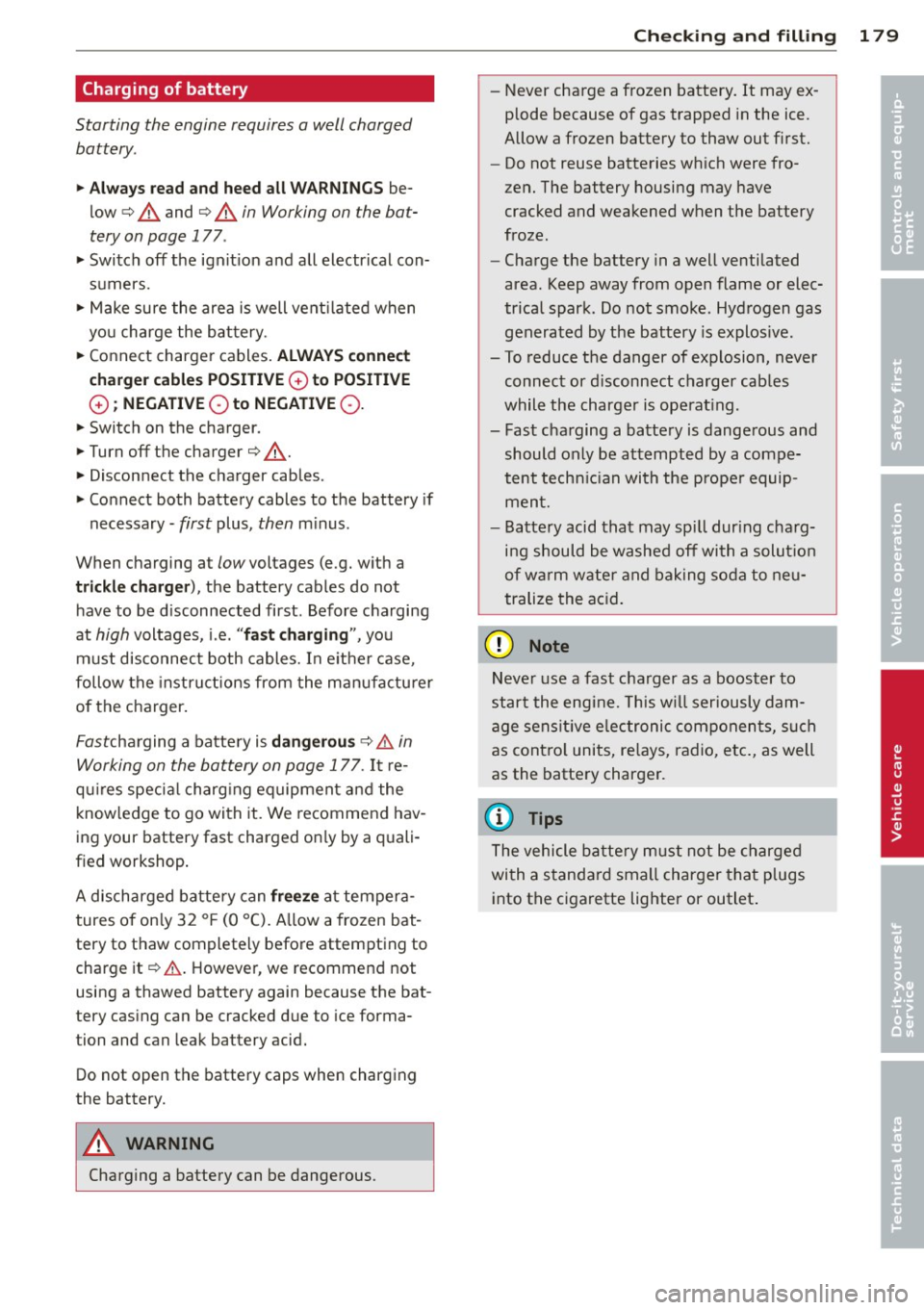
Charging of battery
Starting the engine requires a well charged battery.
11-Al way s read and heed all WARNING S be
low¢
A and ¢ A in Working on the bat
tery on page 177.
11-Switch off the ignit ion and all electrical con
sumers.
11-Make sure the area is well vent ilated when
you charge the bat tery.
11-Connect charger cables. ALWAY S co nnect
charge r cables POSITI VE
G) to POSITIVE
G) ; NEGATIVE Qto NEGA TIV E Q .
11-Switch on the charger.
11-Turn off the charger¢ &_.
11-Disconnect the charger cables.
11-Connect both battery cables to the battery if
necessary -
first plus, then m inus.
When charging at
low voltages (e.g. with a
trickle charg er), the battery cables do not
h ave to be d isconnected first. Before charging
at
high voltages, i.e. " fas t charging ", you
must disconnect both cables. In e ithe r case,
follow the instru ctions from the man ufactu rer
of the charger .
Fastcharging a battery is
dan gerou s¢ & in
Working on the battery on page 177.
It r e
q ui res specia l charg ing equipment and the
know ledge to go with it. We recommend hav
ing your battery fast charged on ly by a quali
f ied workshop .
A discharged battery can
freeze at tempera
tures of on ly 32 °F (0 °C). A llow a frozen bat
tery to thaw completely befo re attempting to
charge it¢ & . However, we recommend not
using a thawed battery again because the bat
tery cas ing can be cracked due to ice forma
tion and can leak battery acid.
Do not open the battery caps when charging
the battery.
A WARNING
-
Charging a battery can be dangerous.
Checkin g and fillin g 179
-Never charge a frozen battery. It may ex
plode because of gas trapped in the ice.
Allow a frozen battery to thaw out first.
- Do not reuse batteries wh ich were fro
zen. The battery housing may have
cracked and weakened when the battery
froze.
- Charge the battery in a well ventilated
area. Keep away from open flame or elec
trical spark. Do not smoke. Hydrogen gas
generated by the battery is explos ive.
- To reduce the danger of explosion, never
connect or d isconnect c harger cab les
while the charger is ope rat ing.
- Fast cha rging a batte ry is dangerous and
should only be attempted by a compe
tent techn ic ian with the prope r equip
men t.
- Battery acid that may spi ll dur ing cha rg
i n g should be washed off wi th a solu tion
of wa rm w ater and baking soda to neu
trali ze the ac id.
(D Note
Neve r use a fast cha rg er as a boost er to
star t the engi ne. This w ill ser iously dam
age sens it ive e lectronic componen ts, su ch
as cont ro l units, re lays, radio, etc., as well
as the batte ry charger.
(D Tips
T he vehicle ba tte ry mu st not be charged
wi th a standa rd small charger that plugs
into t he cigarette lighter or outlet . •
•
Page 182 of 244
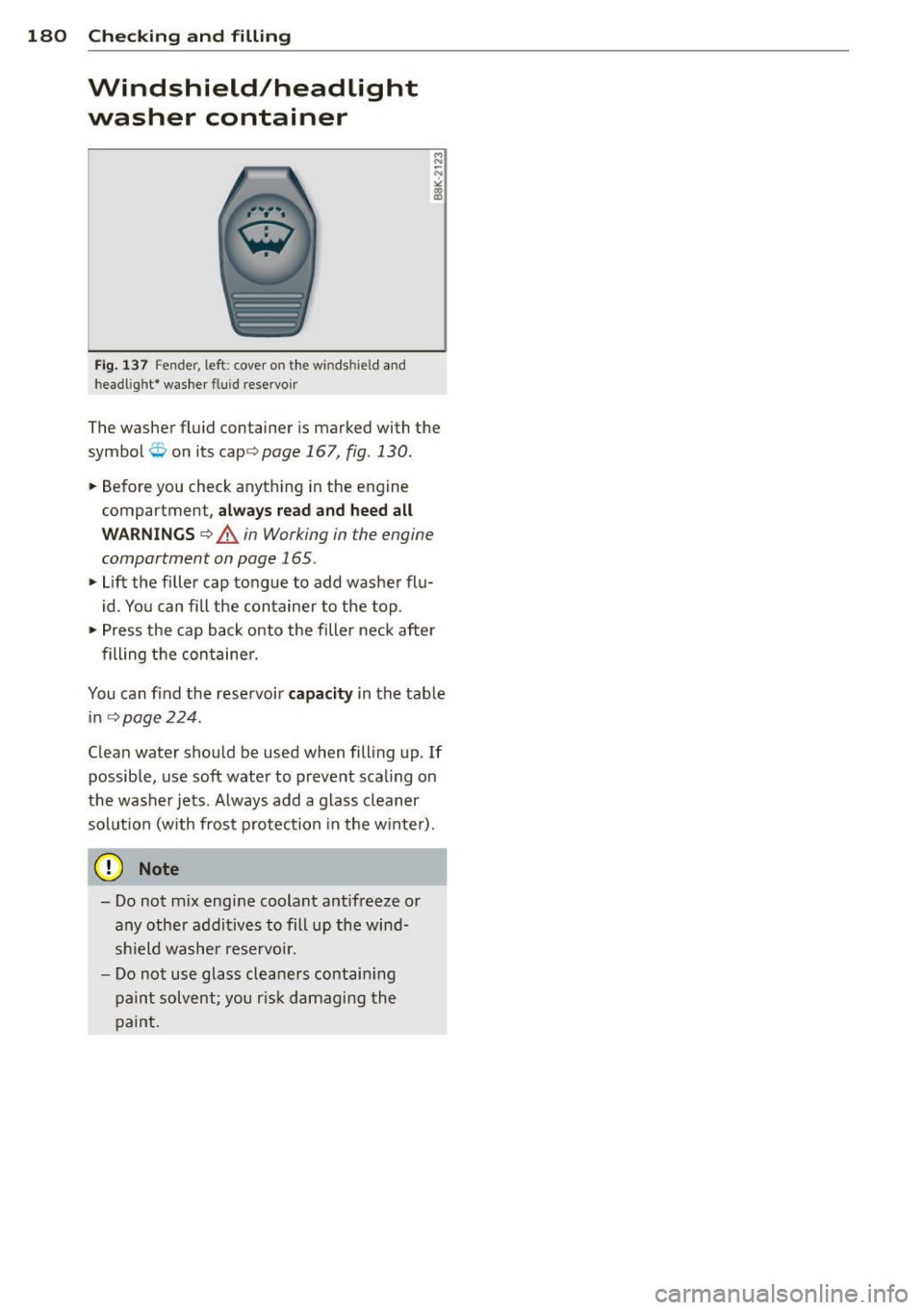
180 Checking and filling
Windshield/headlight
washer container
M N
Fi g. 137 Fender , left : cover on t he w inds hield a nd
headl ig ht* was her fl uid reservoir
The washer flu id container is marked wi th the
symbol
Q on its cap <=>page 16 7, fig . 130 .
.. Before you check anyth ing in the engine
compartment,
alw ays re ad an d heed all
W ARNING S r=> A in Working in the engine
compartment on page 165 .
.,. Lift the filler cap tongue to add washer flu
id . You can fill the container to the top .
.,. Press the cap back onto the fi ller neck after
filling the containe r.
You can find the reservoir
ca pacity in the table
i n
r=> page 224 .
Clean water should be used when filling up . If
possible, use soft water to prevent scal ing on
the washer jets . Always add a glass cleaner
solutio n (with frost p rotection in the winter) .
(D Note
-Do not mix engine coolant antifreeze or
any other addi tives to fill up the wind
shield washer rese rvoi r.
- Do not use glass cleaners contain ing
paint solvent; you r isk damaging the
paint.
Page 183 of 244
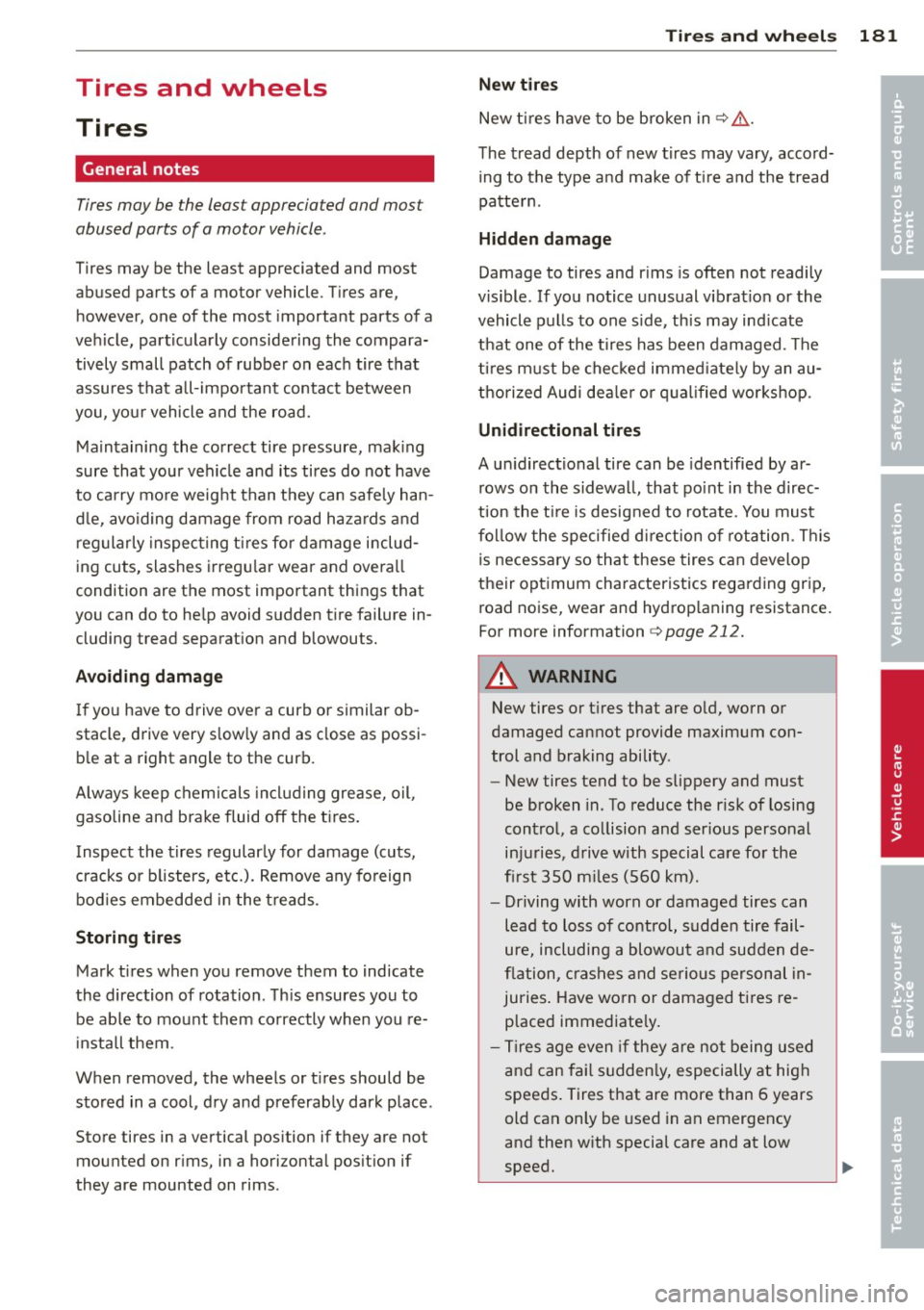
Tires and wheels
Tires
General notes
Tires may be the least appreciated and most
abused parts of a motor vehicle .
Tires may be the least appreciated and most
abused parts of a motor vehicle . Tires are,
however, one of the most important parts of a
vehicle, particularly considering the compara
tively small patch of rubber on each tire that
assures that a ll- important contact between
you, your vehicle and the road.
Maintaining the correct tire pressure, mak ing
sure that your vehicle and its tires do not have
to carry more weight than they can safely han
d le, avoiding damage from road hazards and
r eg ularly inspect ing t ires for damage i nclud
ing cuts, slashes irregu la r wear and ove rall
condition are the most important things that
you can do to he lp avoid sudden tire failure in
cluding tread separat ion and blowouts.
A vo idin g damage
If you have to drive over a curb or similar ob
stacle, drive very slow ly and as close as possi
b le at a right angle to the curb.
A lways keep chemicals includ ing grease, o il ,
gasoline and brake fluid off the t ires .
I nspect the t ires regularly for damage (cuts,
cracks or b listers, etc.). Remove any fo reign
bod ies embedded in the treads.
Storing tires Mark tires when you remove them to indicate
the direction of rotation . Th is ensures you to
be ab le to mount them correctly when you re
i nstall them .
When removed, the wheels or t ires should be
sto red in a cool, dry and preferably dark place .
Store tires in a vertical pos ition if they are not
mounted on rims, in a horizontal pos it ion if
they are mounted on rims .
Tires an d wheel s 181
New tires
New ti res have to be broken in¢& .
The tread depth of new t ires may vary, accord
ing to the type a nd make of t ire and the tread
patte rn.
H idden damage
Damage to tires and r ims is often not readily
visible . If you notice unusual v ib rat ion or the
vehicle pulls to one s ide, th is may ind icate
that one of the t ires has been damaged . T he
ti res m ust be chec ked immed iate ly by an au
thorized Audi dea le r or q ua lified wor kshop .
Unidirectional tires
A un idirectional tire can be identified by ar
rows on the sidewa ll, that po int in the direc
tion the t ire is designed to rotate. You must
f ol low the specified di rection of rotation . T his
is necessary so that these tires can develop
their optimum characteristics regarding grip, road noise, wear and hydrop laning resistance.
For more information
¢ page 212.
A WARNING
New tires or t ires that are o ld, worn or
damaged cannot provide maximum con
trol and braking ability .
-
-New tires tend to be slippery and must
be broken in. To reduce the r isk of losing
control, a co llision and ser ious personal
in ju ries, d rive with special ca re for the
fi rst 350 m iles (560 km).
- Driving with worn or damaged tires can
lead to loss of control, sudden tire fail
ure, including a blowout and sudden de
fl ation, cras hes and se riou s personal in
juries . Have worn or damaged t ires re
placed immediate ly.
- Tires age even if they are not being used
and can fai l sudden ly, especially at hig h
speeds. Tires that are more than 6 years
old can only be used in an emergency
and then w ith special care and at low
speed.
•
•
Page 184 of 244
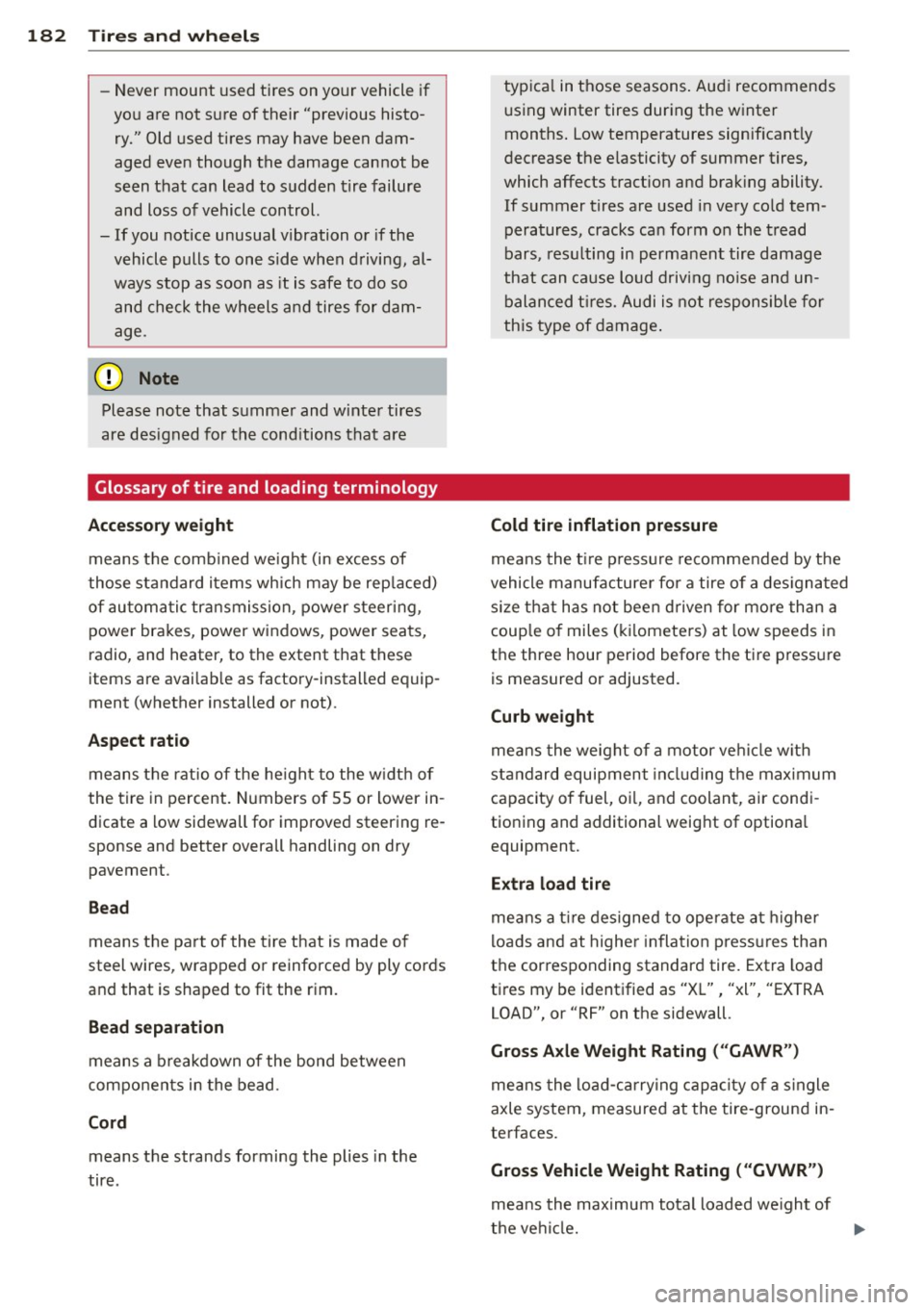
182 Tire s and wheel s
-Never mount used tires on yo ur vehicle if
yo u are not sure of their "previous histo
ry." Old used tires may have been dam
aged even though the damage cannot be
seen that can lead to sudden t ire failure
and loss of vehicle control.
- If you notice unusual vibration or if the
vehicle pulls to one side when driving, al
ways stop as soon as it is safe to do so
and check the wheels and tires for dam
age.
(D Note
Please note that summer and wi nte r tires
are designed for the cond itions that are
Glossary of tire and loading terminology
Accessory weight
means t he comb ined we ight (in excess of
those sta ndard items which may be rep laced)
of au toma tic tra nsmission, power s teer ing,
power brakes, power windows, power seats,
ra dio, and heater, to the extent that th ese
items are availab le as factory -installed equip
ment (whether installed or not) .
Aspect ratio
means t he ratio of the he ight to the w idth of
the tire in percent . Numbers of 55 or lower in
dicate a low sidewall for improve d steering re
sponse and better overall handling on dry pavement .
Bead
means the part of the ti re that is made of
steel wires, wrapped or reinforced by ply cords
and that is shaped to fit the rim.
Bead separation
means a b reakdown of the bond between
components in the bead.
Cord
means the strands forming the plies in the
tire . typ
ica l in those seasons . Aud i recommends
using winter tires during the winter
months . Low temperatures signif icant ly
decrease the e lasticity of summer tires,
which affects tract ion a nd brak ing ability.
If summer tires are used in very co ld tem
peratures, cracks ca n form on the tread
bars, res ulting in permanent tire damage
that can cause loud driving no ise and un
balan ced t ires. Audi i s not responsible for
th is type of damage .
Cold tire inflation pressure
means the tire p ress ure recommended by t he
vehicle manufacture r fo r a tire of a des igna ted
s iz e t hat has not bee n driven for more than a
coup le of miles (k ilometers) at low speeds in
t h e three hour period before the tire pressure
is measured or adjusted.
Curb weight
mea ns the we ight of a motor ve hicle with
standard equipment in clu din g the max imum
capacity of fuel, oil, and coolant, air condi
tioning and additional weight of optiona l
equipment.
Extra load tire
me ans a tire designed to ope rate a t higher
loads and at highe r inflation p ress ures than
the corresponding standard tire. Extra load
tires my be identified as "XL", "xl", "EXTRA
LOAD", or "RF" on the sidewall.
Gross Axle Weight Rating ("GAWR ")
me ans the lo ad -c a rry ing c apac ity of a s ingle
axle system , measured a t the tire-ground in
terfaces.
Gross Vehicle Weight Rating ("GVWR ")
mea ns the max imum total loaded we ight of
t h e ve hicl e. .,.
Page 185 of 244
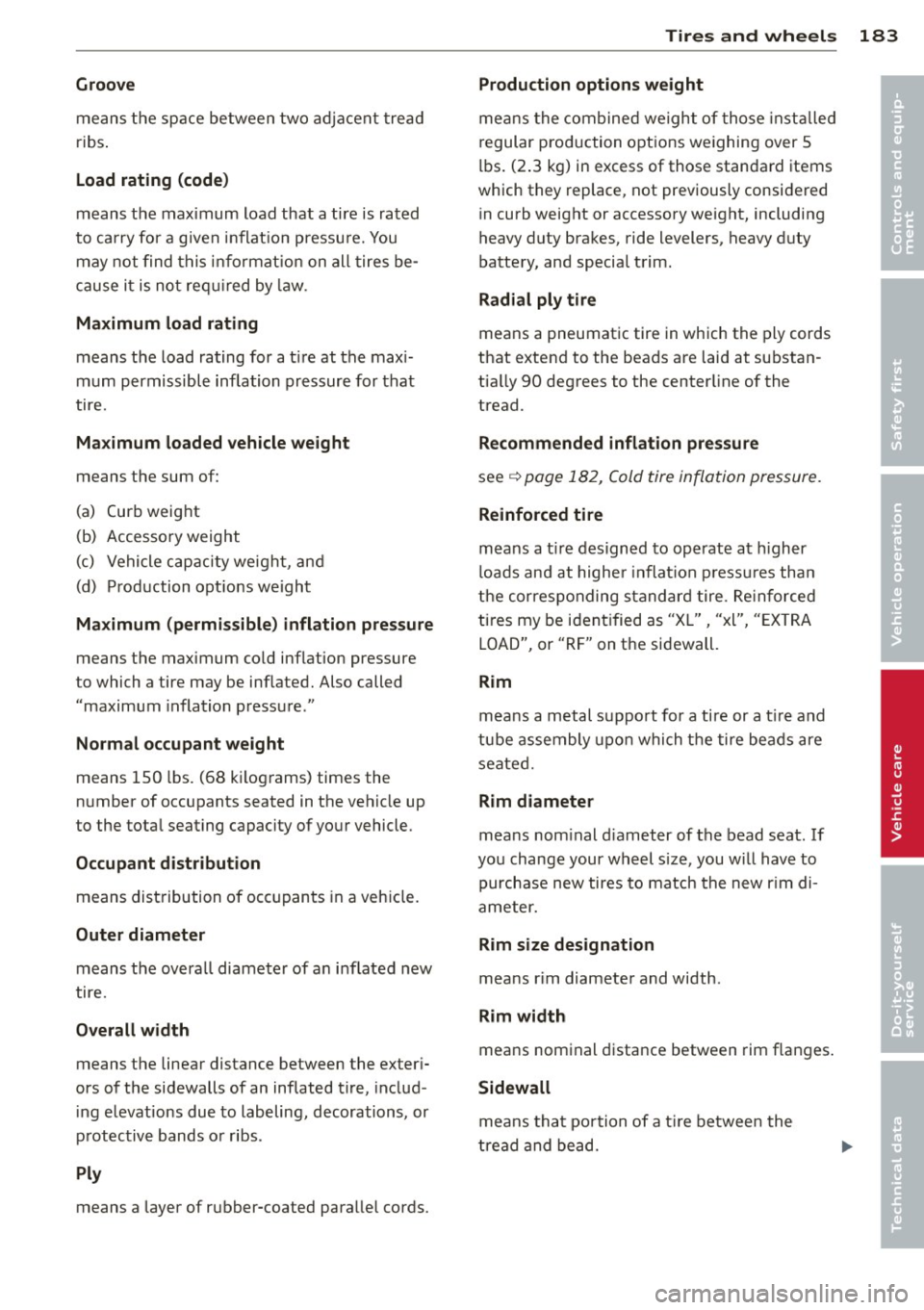
Groove
means the space between two adjacent tread
ribs.
Load rating (code)
means the maximum load that a tire is rated
to carry for a given inflation pressure. You
may not find this information on all tires be
cause it is no t req uired by law.
Maximum load rating
means the load rating for a t ire at the max i
mum permissible inflation pressure for that
tire.
Maximum loaded vehicle weight
means the sum of:
(a) Curb weight
(b) Accessory weight
(c) Vehicle capacity weight, and
(d) Production options weight
Maximum (permissible) inflation pressure
means the maximum cold inflation pressure
to which a tire may be inflated. Also called "maximum inflation pressure."
Normal occupant weight
means 150 lbs. (68 kilograms) times the
number of occupants seated in the vehicle up
to the total seating capacity of your vehicle.
Occupant distribution
means distribution of occupants in a vehicle.
Outer diameter
means the overa ll diamete r of an inflated new
tire.
Overall width
means the linear distance between the exteri
ors of the sidewalls of an inflated tire, includ
in g elevations due to labeling, decorations, or
protective bands or ribs.
Ply
means a layer of rubber-coated parallel cords.
Tires and wheels 183
Production options weight
means the combined weight of those installed
regular production options we ighing over 5
lbs. (2.3 kg) in excess of those standard items
which they replace, not previously considered
in curb weight or accessory weight, including
heavy duty brakes, ride levelers, heavy duty
battery, and special trim.
Radial ply tire
means a pneumatic tire in wh ich the ply cords
that extend to the beads are laid at substan
tia lly 90 degrees to the center line of the
tread .
Recommended inflation pressure
see ¢ page 182, Cold tire inflation pressure.
Reinforced tire
means a t ire designed to operate at higher
loads and at higher inflat ion pressures than
the corresponding standard tire . Reinforced
tires my be identified as "XL", "xl", "E XTRA
LOAD", or "RF" on the sidewall.
Rim
means a metal support for a tire or a tire and
tube assembly upon which the tire beads are
seated.
Rim diameter
means nom inal d iameter of the bead seat. If
you change your wheel s ize, you will have to
purchase new tires to match the new rim di
ameter.
Rim size designation
means r im diameter and width .
Rim width
means nominal distance between rim flanges .
Sidewall
means that portion of a tire between the
tread and bead. •
•
Page 186 of 244
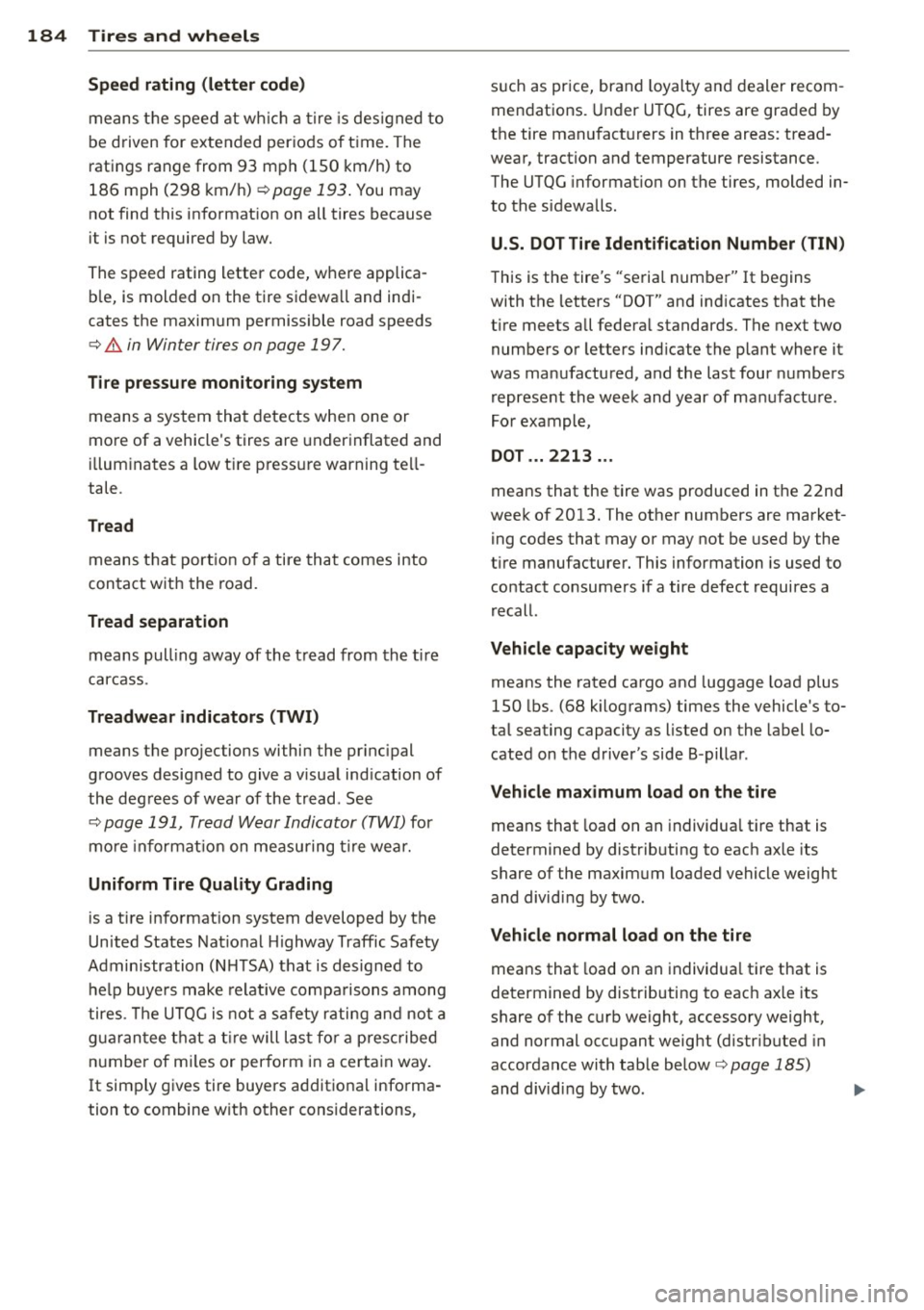
184 Tires and wheels
Speed rating (letter code)
means the speed at wh ic h a tir e is des igned to
be d riven for extended per io d s o f time. The
ratings range from 93 mph (150 km/h) to
186 mph (298 km/h)
¢ page 193. You may
not find this in format ion on all tires because
it is not required by law.
The speed rating letter code, w here a pplica
b le, is molded on the tire s idewa ll and indi
cates the maxim um permissible road speeds
¢ &. in Winter tires on page 197.
Tire pressure monitoring system
means a sys tem that detects whe n one or
mo re of a vehicle's t ires a re under inflated and
il lum inates a low t ire p ress ure warn ing te ll
tale.
Tread
means t hat port ion of a tire tha t comes into
con tact w it h t he road.
Tread separation
means pull ing away of the t read from the t ire
car cass .
Treadwear indicators (TWI)
means t he p rojections withi n the pr inc ipal
g rooves desig ned to give a v isua l ind ication of
the deg rees of wea r of the tre ad . See
¢
pag e 191, Tread W ear Indicator (TWI) for
mo re inf ormat io n on measu ring tire we ar.
Uniform Tire Quality Grading
is a ti re i nfo rmation system developed by the
United States Nat io nal Highway Traffic Safety
Admi nistration (N HTSA) that is designed to
h e lp buye rs m ake re lative compa risons among
tires. The UT QG i s n ot a safety r ating an d no t a
g ua ran tee t hat a tir e will las t fo r a presc ribed
n umber of m iles or per form i n a certa in way .
It sim ply g ives tire buyers a dditio na l info rma
tion to combine w ith other considerations, s
u ch as pr ice, brand loyalty a nd dealer recom
me ndations. Under U TQG, tires are gra ded by
t h e tire man ufact urers in three areas : tread
wear, traction and temperature resistance .
The UTQG informat io n on the tires, m olded in
to the sidewalls .
U.S. DOT Tire Identification Number (TIN )
This is the tire's "se ria l numbe r" It begins
with the letters "DOT" and ind icates that the
t ir e meets all federa l standards. The next two
numbers or letters ind icate the plant where it
was ma nufactu red, and the last four numbe rs
r eprese nt the week and year of ma nufact ure.
Fo r exampl e,
DOT ... 2213 ...
means that the tire was produced in t he 22nd
wee k of 2013. The ot her numbers are market
ing codes that may or may not be used by the
t ire manufacturer . This information is used to
contact consumers i f a tire defect requires a
r ecall .
Vehicle capacity weight
means the rated cargo and luggage load p lus
150 lbs. (68 k ilograms) times the vehicle's to
ta l seating capacity as listed on the label lo
cated on the driver's side B-pilla r.
Vehicle maximum lo ad on the tire
means that load on an individua l tire that is
determined by distrib uting to eac h axle its
share of the maxim um loaded vehicle weight
and divid ing by two .
Vehicle normal load on the tire
means that load on an individua l t ir e that is
determined by distrib uting to eac h ax le its
share of the curb weight, accessory weight,
and normal occ upant weig ht (d istr ibuted in
accorda nce wit h tab le below¢
page 185)
and divid ing by two .
Page 187 of 244
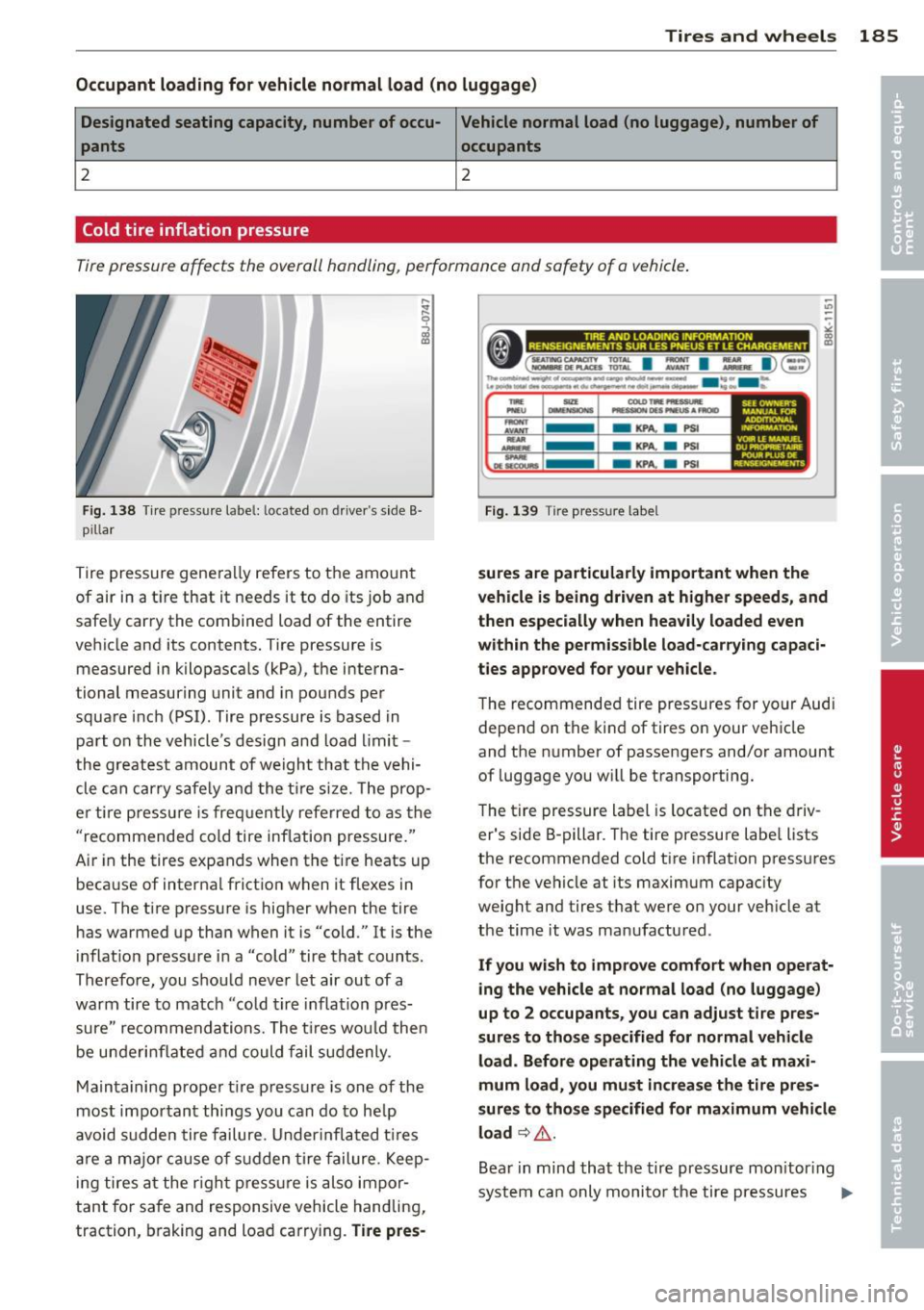
Tires and wheels 185
Occupant loading for vehicle normal load (no luggage)
Designated seating capacity, number of occu- Vehicle normal load (no luggage), number of
pants occupants
2 2
Cold tire inflation pressure
Tire pressure affects the overall handling, performance and safety of a vehicle.
Fig . 138 Tire pressure label: located on driver's s ide B·
pillar
Tire pressure generally refers to the amount
of air in a tire that it needs it to do its job and
safely carry the combined load of the entire
vehicle and its contents. Tire pressure is
measured in kilopasca ls (kPa), the interna
tional measuring unit and in pounds per
square inch (PSI) . Tire pressure is based in
part on the vehicle's desig n and load limit -
the greatest amount of weight that the vehi
cle can carry safely and the tir e size. The prop
er tire pressure is frequently referred to as the
"recommended cold tire inf lation pressure."
Air in the tires expands when the tire heats up
because of internal friction when it flexes in
use. The tire pressure is higher when the tire
has warmed up than when it is "cold ." It is the
inflation pressure in a "cold" tire that counts.
Therefore, you should neve r let air out of a
warm tire to match "cold tire inflation pres
sure" recommendations. The tires would then
be underi nflated and could fail suddenly .
Maintaining proper tire pressure is one of the
most important things you can do to help
avoid sudde n tire failure . Underinflated tir es
are a major cause of sudden tire failure . Keep
ing tires at the right press ure is also impor
tant for safe and responsive vehicle handling,
traction, braking and load carrying.
Tire pres-
-"' -
-----------------~ ,.
•(=~: I := I :::. I) ('::- ) :8
n- ............ .,~-------...---- .... _ ... &,. ............................... ~----·-..
TN Sill COI.DJN ""5Ulll PHW DIMUCSl:>HS PM.ISIOHOHPHEUSA,...,
-AVANT -KPA. • PSI
-- -KPA. a PSI
-°'"""""' -KPA. a PSI
Fig. 139 Tire pressure labe l
SEE OWNER"$ MAMJAl FOR A L _.,..,..
VOIIIUMAM..JEt OU PROPAIETAI~ ,OUft P'l us Of RENSEIGHEMEN'TS
sures are particularly important when the
vehicle is being driven at higher speeds, and
then especially when heavily loaded even
within the permissible load-carrying capaci
ties approved for your vehicle.
The recommended tire pressures for your Audi
depend on the kind of tires on your vehicle
and the number of passengers and/or amount
of luggage you will be transporting.
The tire pressure label is located on the driv
er's side B-pillar. The tire pressure labe l lists
the recommended cold tire inflation pressures
for the vehicle at its maximum capacity
weight and tires that were on your vehicle at
the time it was manufactured .
If you wish to improve comfort when operat
ing the vehicle at normal load (no luggage)
up to 2 occupants, you can adjust tire pres
sures to those specified for normal vehicle
load. Before operating the vehicle at maxi
mum load, you must increase the tire pres
sures to those specified for maximum vehicle
load ¢,& .
Bea r in mind that the tire pressure mon itor ing
system can only monitor the tire pressures ..,_
Page 188 of 244
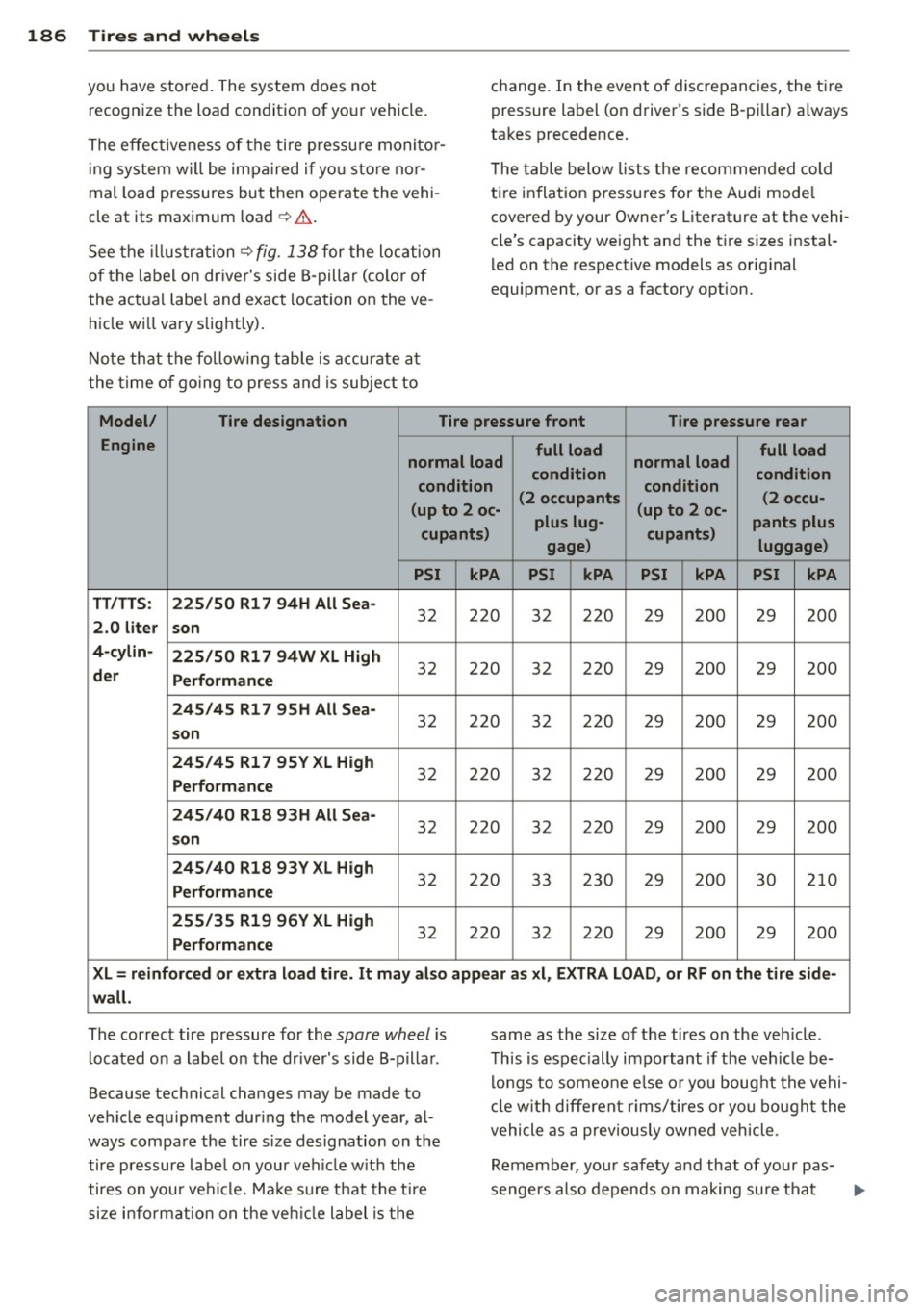
186 Tire s and wheel s
you have stored . The system does not
recognize the load condition of your vehicle.
The effectiveness of the tire pressu re monito r
ing system w ill be impaired if yo u store nor
mal load pressures but then operate the vehi
cle at its maximum load¢.&..
See the il lustration¢
fig. 138 for the location
of the label on dr iver's side 8-pillar (color of
the actua l labe l and exact location on the ve
hicle wi ll vary slightly).
Note that the followi ng tab le is accurate a t
the time o f go ing to press and is subject to change. In the
event of discrepancies, the t ire
pressure label (on driver's side 8-pi llar) a lways
takes precedence .
T he table below lists the recommended cold
ti re inflation pressu res for the Audi mode l
covered by your Owner's Literature at the vehi
cle's capacity weight and the t ire sizes instal
l ed on the respective models as original
equipment, or as a factory option.
Model/ Tire designation
Tire pressure front Tire pressure rear
Engine full load full load
no rmal load
condition normal load
condition
condition (2 occupants condition
(2 occu-
( up to 2 oc-
plus lug- (up to 2 oc-
pants plus
cupants)
gage) cupants)
luggage)
PSI kPA PSI kPA PSI kPA PSI kPA
TT /TTS : 22 5/50 Rl 7 94H All Sea -
32 220 32 220 29 200 29 200 2.0 liter son
4-c ylin-225 /50 Rl 7 94W XL High
d er
Perf orm ance
32 220 32 220 29 200 29 200
2
45 /4 5 Rl 7 95 H All Sea-
32 220 32 220 29 200 29 200 son
245 /45 Rl7 95YX L High
32 220 32 220 29 200 29 200 Perf ormance
245 /40 R1 8 93H All S ea-
32 220 32 220 29 200 29 200 son
2 45 /40 Rl8 9 3Y XL High
32 220 33 230 29 200 30 210 Perform ance
25 5/35 Rl 9 96Y XL Hi gh
32 220 32 220 29 200 29 200 Perf or mance
X L= r ein for ce d or e xtra lo ad tire . It m ay also a ppear as xl, EX TRA LO AD, or RF on th e tire side-
w all.
The correct tire pressure for the spare wheel is
l ocated on a label on the driver's side 8-pillar.
Because technical changes may be made to
vehicle equ ipment dur ing the model year, al
ways compare the tire size designation on the
tire pressure labe l on your vehicle w ith the
tires on your vehicle. Ma ke sure that the tire
size information on the vehicle label is the same
as the size of the tires on the veh icle.
T his is espec ially important if the veh icle be
longs to someone e lse or you boug ht the vehi
cle w ith different rims/tires or you bought the
vehicle as a previously owned veh icle.
Remember, your safety and that of your pas-
sengers also depends on making sure that
II>-
Page 189 of 244
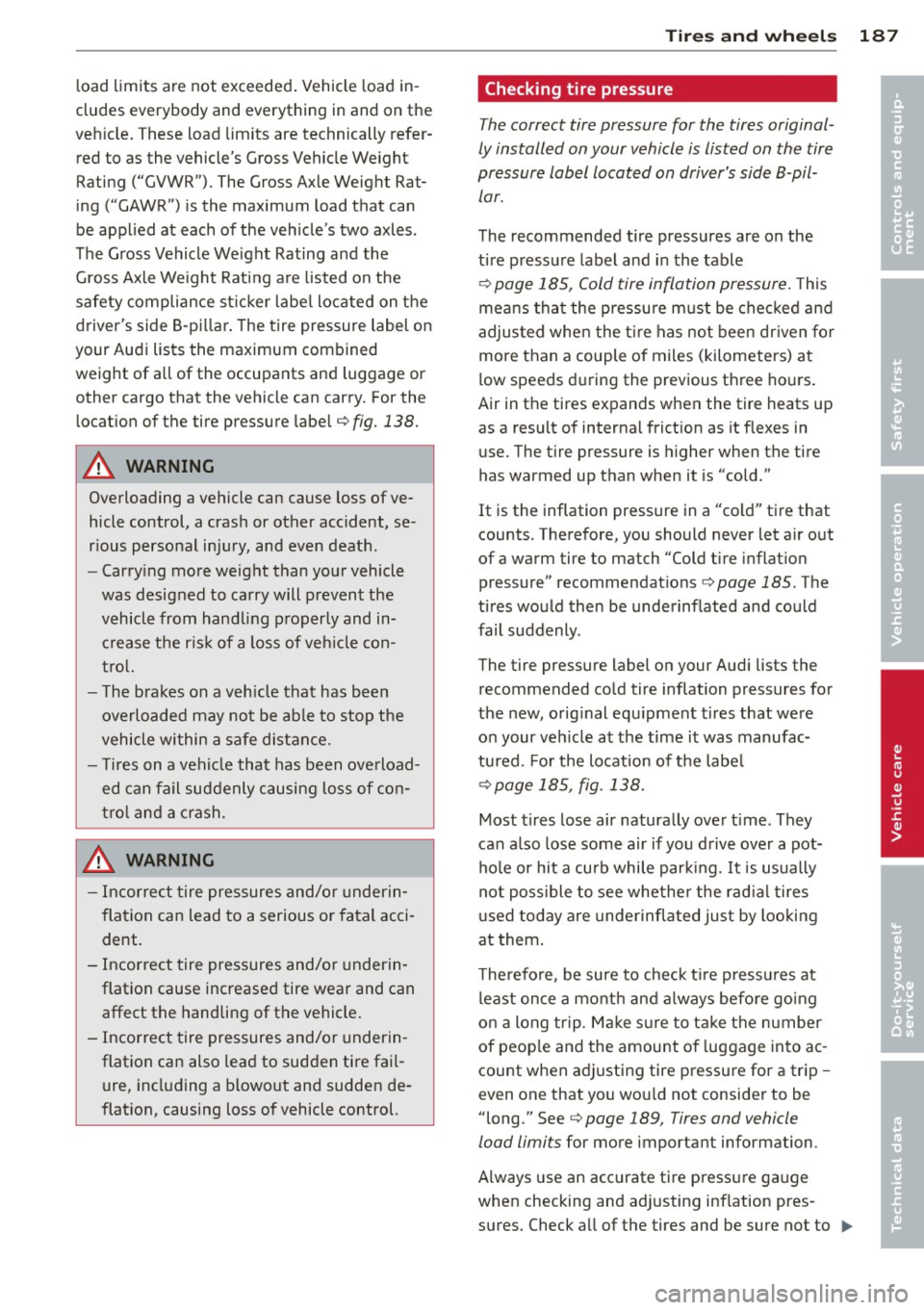
load limits are not exceeded . Vehicle load in
cludes everybody and everything in and on the
veh icle. These load limits are technically refer
red to as the vehicle's G ross Vehicle We ight
Rating ("GVWR") . The Gross Axle Weight Rat
ing ("GAWR") is th e ma ximum load that can
be ap plied at each of the veh icle's two axles .
The Gross Ve hicle We ight Rating and the
Gross Axle We igh t Rating a re listed on the
safety compliance st icker labe l located on the
d river's side 8-p illa r. T he tire pressure label on
your Audi lists the maximum combined weight of all of the occupants and luggage or
other cargo that the vehicle can carry. For the locat ion of the tire pressure label¢
fig. 138.
A WARNING
Overloading a vehicle can cause loss of ve
hicle control, a cras h or other accident, se
r ious personal inju ry, and even death.
- Carry ing more weight than your vehicle
was designed to carry will prevent the
vehicle from handling properly and in cr ease the ris k of a loss of veh icle con
t ro l.
- T he bra kes on a veh icle that has been
overloaded may no t be ab le to stop t he
vehicle within a sa fe distance.
- T ires on a vehicle that has been ove rload
ed can fail suddenly causing loss of con
t ro l and a c rash.
A WARNING
- Incorre ct ti re pressures and/or underin
fla tion can lead to a serious o r fata l acci
dent.
- Incorrect tire pressures and/or underin
flation cause increased tire wea r and can
affect the handling of the vehicle .
- Incorrect tire pressures and/or underin
flation can also lea d to sudden tire fa il
u re, incl uding a b lowo ut and sudden de
flation, causing loss of vehicle control.
Tire s an d wheel s 187
Checking tire pressure
The correct tire pressure for the tires original
ly installed on your vehicle is listed on the tire
pressure label located on driver's side 8-pil lar.
The recommended tire pressures are on the
ti re pressu re label and in the table
¢
page 185, Cold tire inflation pressure. This
mea ns tha t the pressu re m ust be chec ked and
adjus ted when the t ire has not been dr iven fo r
more than a couple of miles (kilometers) a t
low speeds d uring the previous three ho urs.
Air in the tires expands when the tire heats up
as a result of interna l frict ion as it flexes in
use. The tire pressure is higher when the tire
has warmed up than whe n it is "cold."
It is the inflation pressure in a "co ld" t ire that
counts. Therefore, you should never let a ir o ut
of a warm tire to match "Cold t ire inflat ion
pressure" recomme ndat io ns¢
page 185 . The
ti res wou ld then be underinflated and could
fail suddenly .
The tire pressure label on your Audi lists the recommended co ld tire inflation pressures for
the new, orig inal equ ipment tires that we re
on your veh icle at the time it was manufac
tured. Fo r the location of t he labe l
¢page 185, fig. 138.
Most tires lose air natura lly ove r time . They
can a lso lose some air if you d rive over a pot
hole or hit a curb while par king.
It is usually
not po ss ible to see whethe r the rad ia l t ires
u sed today are underinflated just by loo king
at them .
T he refore, be sure to check t ire p ressu res at
l east once a mo nth and a lways befo re goi ng
on a long t rip. M ake s ure to ta ke the n umber
of peop le and the amount o f luggage into ac
count when adjusting tire pressure for a trip -
even one that yo u wou ld not conside r to be
"long." See ¢
page 189, Tires and vehicle
load limits
for more important information .
A lways use an acc urate tire pressure ga uge
when checking and ad justing inflation pres
s u res. Check all of the tires and be sure not to ..,.
•
•
Page 190 of 244
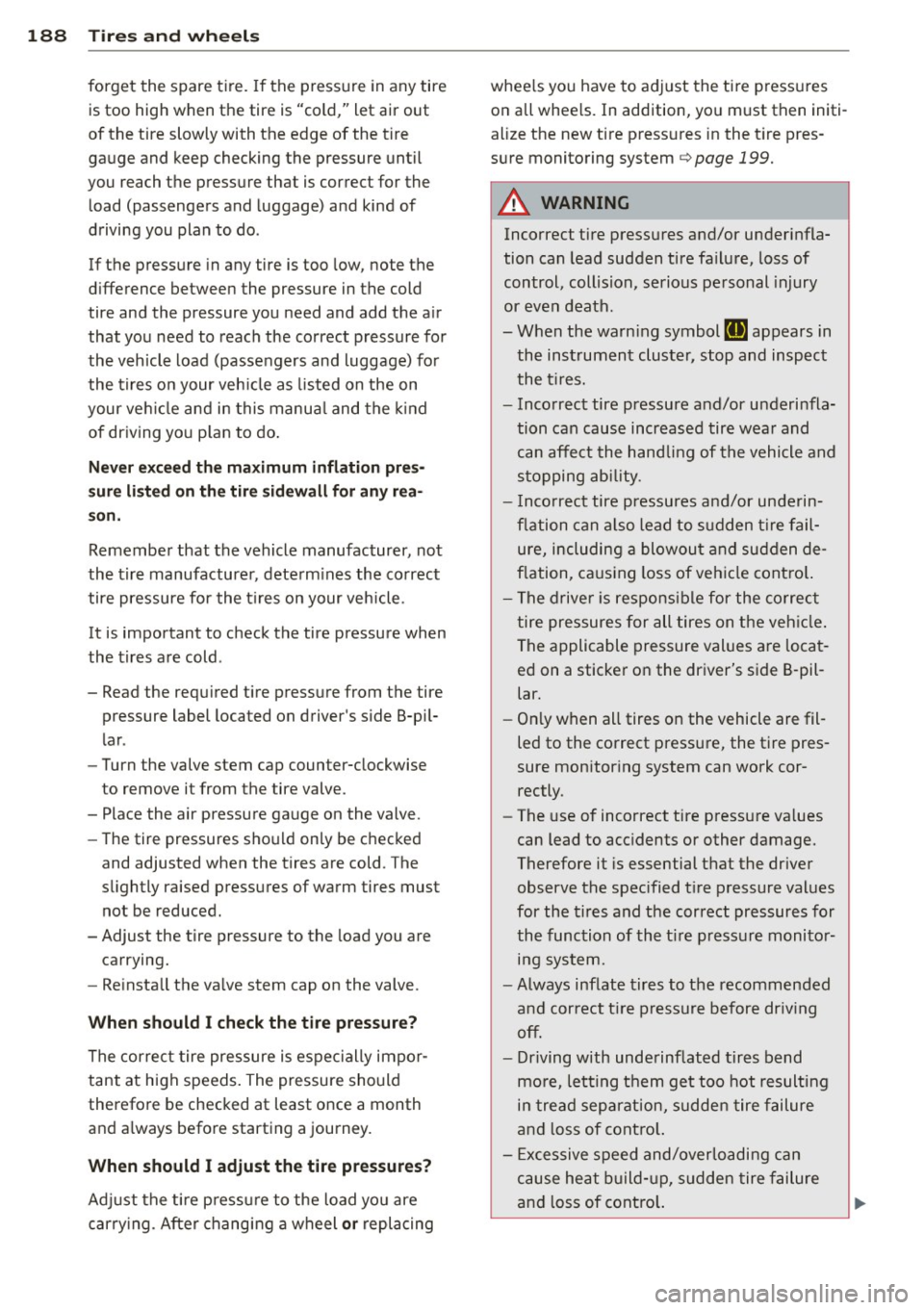
188 Tire s and wheel s
forget the spare tire. If the pressure in any tire
is too high when the tire is "cold," let air out
of the tire slowly with the edge of the tire
ga uge and keep checking the pressure until
you reach the pressure that is correct for the
load (passengers and luggage) and kind of
driving you plan to do.
If the pressure in any tire is too low, note the
d ifference between the pressure in the cold
tire and the pressure you need and add the air
that you need to reach the correct pressure for
the vehicle load (passengers and luggage) for
the tires on your veh icle as listed on the on
your ve hicle and in this manua l and the kind
of dr iving you p lan to do .
Never exc eed th e maximum inflati on pres
sure listed on th e tir e s idewall for any rea
s on.
Remembe r that the vehicle manufacturer, not
the t ire manufactu rer, determ ines the correct
tire pressure for the t ires on your vehicle.
It is important to check the tire pressure when
the t ires a re cold .
- Read the requ ired tire press ure from the tire
pressure label located on driver's side B-pil
lar .
- Turn the valve stem cap counter-clockwise
to remove it from the tire valve.
- Place the air pressure gauge on the valve.
- The tire pressures sho uld only be checked
and adjusted when the tires are cold. The
slightly raised pressures of warm tires must
not be reduced.
- Adjust the tire pressure to the load you are
carrying.
- Re insta ll the valve stem cap on the valve.
Wh en should I check the tir e pr essure?
The correct tire pressure is espe cially impor
tant at high speeds . The pressure should
therefore be checked at least once a month
and a lways before starting a journey.
When should I ad ju st the tire pressures?
Adj ust the t ire p ressu re to the load yo u are
carry ing . After changing a wheel
or replacing whee
ls you have to adjust the tire p ressures
o n all whee ls. In addition, yo u m ust then initi
alize the new tire press ures in the t ire pres
s u re monitoring system¢
page 199.
A WARNING
Incorrect tire pressures and/or underinfla
tion can lead sudden tire fa ilure, loss of
control, collision, serious pe rsonal injury
or even death.
- When the warn ing symbol
RI] appears in
the instrument cluster, stop and inspect
the t ires.
- Incorrect tire pressure and/or underinfla
tion can cause increased tire wea r and
can affect the handling of the vehicle and
s topping ability.
- I nco rrect tire pressures and/or underin
f lation can a lso lead to s udden t ire fail
ure, including a blowout and su dden de
flation, ca using loss of veh icle cont ro l.
- The drive r is responsible for the co rrec t
tire pressures for all tires on the veh icle .
The applicable pressure values are loca t
ed on a sticker on the driver's side B -pil
lar.
- On ly when all tires on the vehicle are fil
led to the correct pressu re, the tire pres
sure mon itor ing system can work cor
rectly.
- The use of incorrect tire pressu re va lues
can lead to acc idents or other damage.
Therefore it is essential that the driver
observe the spec ified t ire pressure values
for the tires and the correct pressures for
the function of the t i re p ress ure monito r
ing system.
- Always inf late tires to the recommended
and correct t ire pressure before dr iv ing
off.
- Driving with unde rinf lated tires bend
mo re, letting them get too hot resulting
in tre ad separation, sudden tire failure
and loss of cont ro l.
- Excessive speed and/overloading can
cause heat b uild- up, sudden tire failure
and loss of cont ro l.